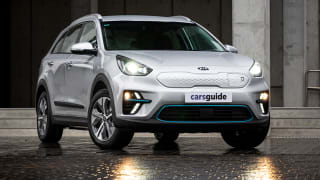
Kia Niro 2021 review: EV Sport
The Kia Niro bursts onto the electric scene with big range, a mainstream SUV shape, and typical Kia practicality, but is it too little to late for the Korean brand?
Browse over 9,000 car reviews
As far as small SUVs go, the Mercedes-Benz GLA has been at the forefront of the premium segment since its second-generation model was released in August 2020.
Fast forward to now, almost a year later, and an all-electric version of the GLA, called EQA, has become available.
But given the EQA is Mercedes-Benz’s most affordable zero-emissions model yet, does its entry-level variant, the EQA 250, offer buyers enough value? Let’s find out.
| Mercedes-Benz EQ-Class 2022: EQA 250 | |
|---|---|
| Safety rating | |
| Engine Type | — |
| Fuel Type | Electric |
| Fuel Efficiency | —L/100km |
| Seating | 5 seats |
| Price from | $74,140 |
While the EQA line-up has launched with a single variant, the front-wheel-drive (FWD) EQA 250 will be joined by the all-wheel-drive (AWD) – and yet-to-be-priced – EQA 350 by the end of 2021.
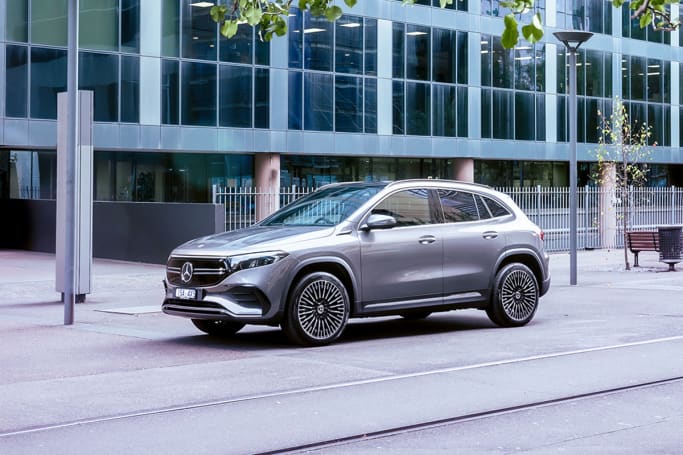
We’ll go through all of the differences between the two later on, but for now, let’s see how the EQA 250 stacks up.
Priced from about $76,800, before on-roads, the EQA 250 costs almost the same as its main rival, the AWD Volvo XC40 Recharge Pure Electric ($76,990), although that model has higher outputs, more closely aligned with the EQA 350.
But when it comes to the EQA 250, it’s also priced about $7000 higher than the equivalent GLA 250, with its standard equipment including dusk-sensing LED lights, rain-sensing wipers, 19-inch alloy wheels (with a tyre repair kit), aluminium roof rails, keyless entry and a hands-free power-operated tailgate.
Inside, the central touchscreen and digital instrument cluster both measure 10.25 inches. with the 'MBUX' multimedia system offering satellite navigation, Apple CarPlay and Android Auto support, and digital radio.
Then there’s the 10-speaker sound system, wireless smartphone charger, power-adjustable front seats with heating, dual-zone climate control, black or beige 'Artico' synthetic leather upholstery, and ambient lighting.
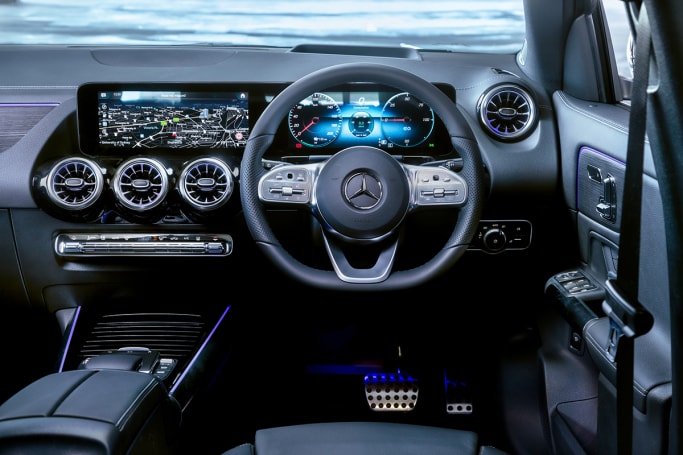
Notable options include a panoramic sunroof ($2300) and the 'MBUX Innovations' package ($2500), which includes a head-up display and augmented reality (AR) satellite navigation, so the EQA 250’s value is questionable in more ways than one.
An 'AMG Line' package ($2950) bundles in a body kit, 20-inch alloy wheels, a flat-bottom steering wheel, front sports seats and unique backlit interior trim.
Externally, it’s pretty easy to pick the EQA out from the GLA and the wider small-SUV crowd thanks to its unique front and rear fascias.
Up front, the EQA’s LED headlights are linked by a more expansive, albeit closed, grille as well as an LED light bar, to give off that seriously futuristic look.
But around the side, the EQA could be mistaken for another GLA variant, with only its unique alloy wheels, ‘EQA’ badge and some chrome trim helping to separate it from the pack.
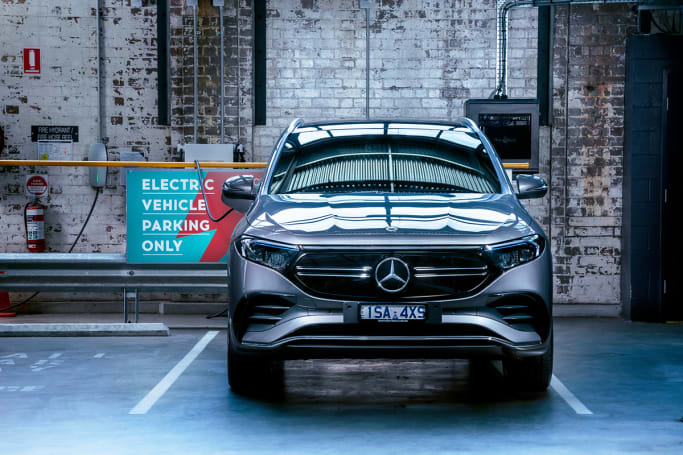
That said, at the rear, there’s no confusing the EQA for anything else, as its bespoke LED tail-lights stretch from side to side to cut quite the striking impression, while the ‘Mercedes-Benz’ badge and number plate are repositioned.
Inside, though, you’d be hard-pressed to tell the difference between the EQA and GLA. Indeed, differentiation is only really achieved if you option the AMG Line package, which comes with unique backlit trim for the dashboard.
That said, the EQA is still a very nice place to be, with the premium feeling heightened by the soft-touch materials used on the dashboard and door shoulders, while the armrests are also comfortable.
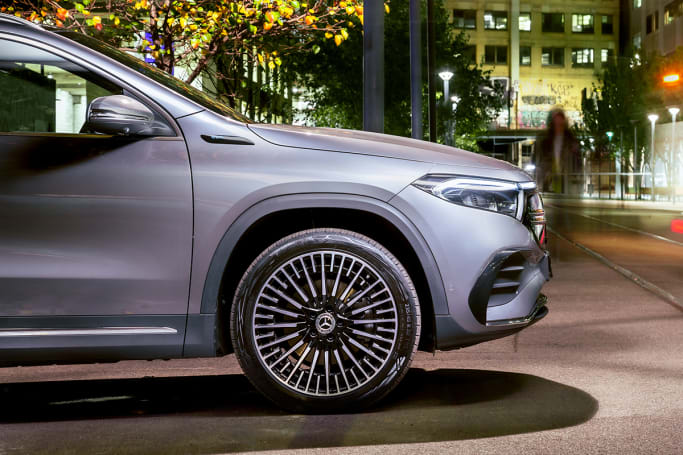
Speaking of which, while Artico synthetic leather upholstery covers the armrests and seats to push the EQA’s sustainability story, Nappa leather (read: real cow hide) ironically trims the steering wheel. Make of that what you will.
The EQA makes a strong statement, though, with its conjoined 10.25-inch displays, with the central touchscreen and digital instrument cluster powered by Mercedes-Benz’s now-familiar MBUX multimedia system. Yep, it’s still arguably best in class.
Measuring 4463mm long (with a 2729mm wheelbase), 1834mm wide and 1619mm tall, the EQA 250 is on the larger side for a small SUV, although its packaging is compromised by its battery.
For example, the EQA 250’s boot has a below-average cargo capacity of 340L, which is 105L less than that of the GLA. That said, it can be increased to a more respectable 1320L when the 40/20/40 split-fold rear bench is stowed.
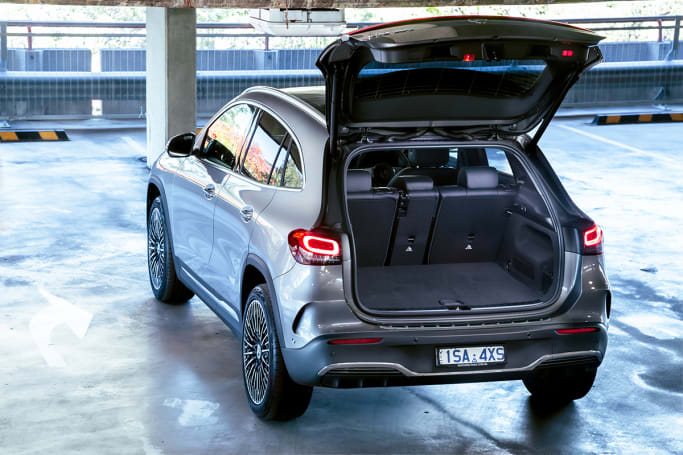
Either way, there’s no load lip to contend with when loading bulkier items, with the boot floor staying flat, no matter the storage configuration. Better yet, two bag hooks, a strap and four tie-down points are on hand for securing loose cargo.
And yes, while the EQA 250 is an all-electric vehicle, it doesn’t have a froot or frunk. Instead, its drivetrain components completely occupy the space under the bonnet, alongside some other key mechanical bits and pieces.
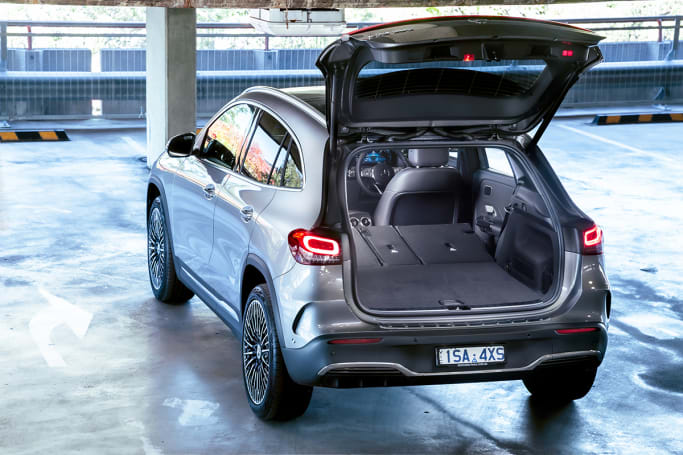
In the second row, the EQA 250’s compromises once again come to the fore, with the raised positioning of the floor leading to occupants more or less squatting when seated on the bench.
While under-thigh support is sorely lacking, nearly 6.0cm of legroom is available behind my 184cm driving position, while a couple of centimetres of headroom is on offer with the optional panoramic sunroof fitted.
The small central tunnel also means passengers won’t really be fighting over precious footwell space. Yep, the rear bench is wide enough that three adults will be able to sit abreast on a shorter journey.
And when it comes to young kids, three top-tether and two ISOFIX anchorage points are on hand for fitting child seats, so the EQA 250 can very much cater for the whole family (depending on its size).
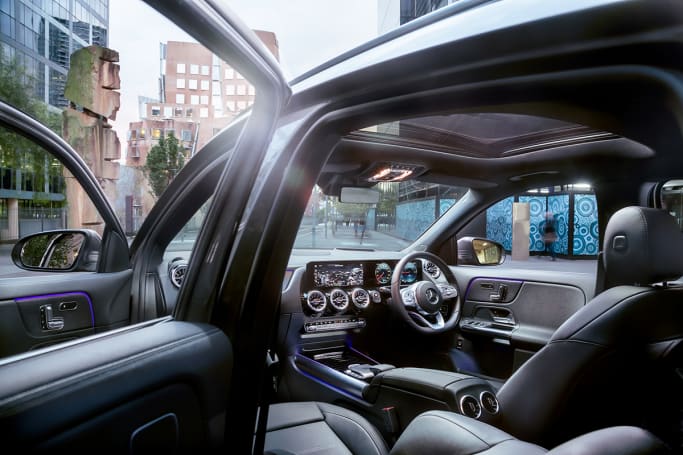
Amenities-wise, the second row has a fold-down armrest with two pop-out cupholders, while its door bins can take another bottle each. Then there’s storage nets on the front seat backrests, and air vents, a USB-C port and a small cubby at the rear of the centre console.
In the first row, things are even better, with the centre console featuring a pair of cupholders, ahead of which are a wireless smartphone charger, a USB-C port and a 12V power outlet. And then the large central bin contains an extra two USB-C ports.
Other storage options include the decently sized glove box, while a staggered three bottles can fit in each of the front door bins. Yep, you’re unlikely to die of thirst in the EQA 250.
The EQA 250 comes with a front-mounted electric motor, which produces 140kW of power and 375Nm of torque. With a kerb weight of 2040kg to deal with, it sprints from a standstill to 100km/h in a respectable 8.9 seconds.
But if you’re after higher performance, the EQA 350 will add a rear-mounted electric motor for combined outputs of 215kW and 520Nm. It will be able to shift its 2105kg frame to triple digits in a hot-hatch-like six seconds flat.
The EQA 250 is fitted with a 66.5kWh battery, which delivers a solid 426km of WLTP-certified range. Its energy consumption is 17.7kWh/100km.
On the other hand, the EQA 350 will use the same battery but will last 6km longer in between charges while requiring 0.2kWh/100km less juice along the way.
In my real-world testing with the EQA 250, I averaged 19.8kWh/100km over 176km of driving, which primarily took place on country roads, although time was spent in the urban jungle.
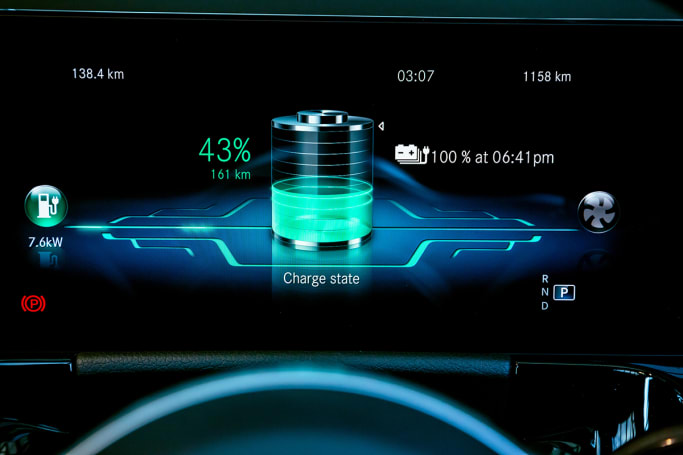
As such, I would’ve been able to get 336km of range out of a single charge, which is a solid return for a city-focused vehicle. And keep in mind, you’d be able to get an even better result without my heavy right foot.
When it does come to charging, though, there’s no difference between the EQA 250 and EQA 350, with their shared battery able to increase its capacity from 10 to 80 per cent in a commendable half an hour when using a 100kW DC fast charger with a CCS port.
Alternatively, the onboard 11kW AC charger with a Type 2 port will do the job in 4.1 hours, which means charging at home or the office will be a breeze no matter the time of day.
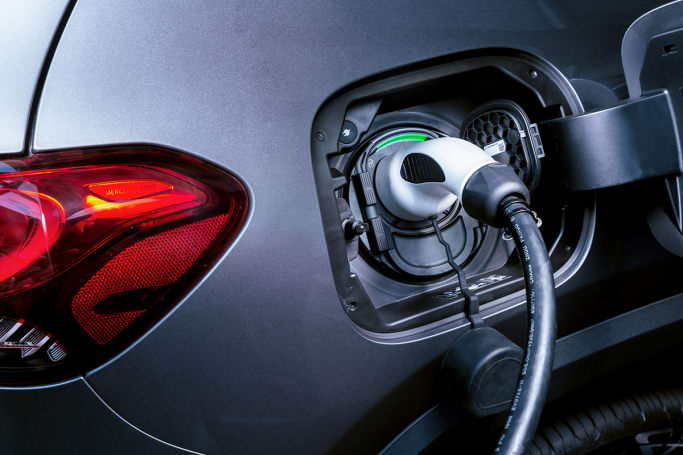
Conveniently, the EQA comes with a three-year subscription to Chargefox’s public EV charging network, which is the largest in Australia.
Neither ANCAP nor its European counterpart, Euro NCAP, has given the EQA, let alone the related GLA, a safety rating, so it’s yet to have its crash performance independently assessed.
That said, advanced driver-assist systems in the EQA 250 extend to autonomous emergency braking with pedestrian detection, lane-keep and steering assist (including emergency functionality), adaptive cruise control and speed sign recognition.
Then there’s high-beam assist, active blind-spot monitoring, rear cross-traffic alert, park assist, a reversing camera, front and rear parking sensors, 'Safe Exit Assist' and tyre pressure monitoring.
While that list is pretty impressive, it’s worth noting surround-view cameras form part of the optional 'Vision Package' ($2900), alongside the aforementioned panoramic sunroof and a 590W Burmester surround-sound system with 12 speakers.
Other standard safety equipment includes seven airbags (dual front, side and curtain plus driver’s knee), anti-lock brakes and the usual electronic traction and stability control systems.
Basic Warranty
5 years / unlimited km warranty
ANCAP Safety Rating

As with all Mercedes-Benz models, the EQA 250 comes with a five-year/unlimited-kilometre warranty and five years of roadside assistance, which currently sets the standard for the premium segment.
That said, the battery is covered by a separate eight-year/160,000km warranty for that extra peace of mind.
Better yet, the EQA 250’s service intervals are relatively long, at every year or 25,000km – whichever comes first.
A five-year/125,000km capped-price servicing plan is available, costing $2200 in total, or an average of $440 per visit, which is fairly reasonable, all things considered.
The EQA 250 is genuinely relaxing to drive. Of course, a lot of the credit for this must go to the powertrain, which excels within the city limits.
The front-mounted electric motor’s 375Nm of torque is nothing to be sneezed at, with its instantaneous delivery helping the EQA 250 get up to 60km/h quicker than most internal-combustion engine (ICE) vehicles, some sports cars included.
That said, the EQA 250’s smooth acceleration does become more leisurely as you approach and exceed highway speeds. It performs well enough, but if you want something that has more bandwidth, consider waiting for the more potent EQA 350.
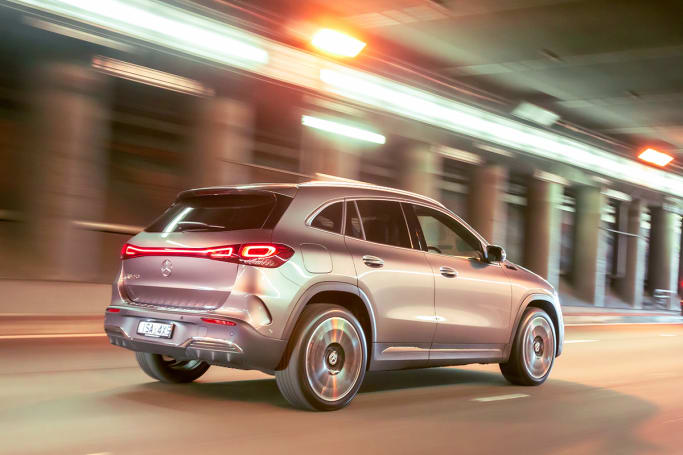
Either way, the EQA 250 does an excellent job of regenerative braking, with Mercedes-Benz offering owners the power of choice. Simply put, if you want to drive it like ‘a normal car’, you can, and if you want to fully embrace zero-emissions driving, you can, too.
There are five modes to choose from, with D Auto using road data to work out the best approach, while the other four (D+, D, D- and D--) can be selected by the steering wheel’s paddle-shifters.
D offers the natural approach, with a slight amount of regenerative braking occurring when lifting off the accelerator, while D-- (my favourite) turns up the aggressiveness to (almost) enable one-pedal driving.
Yep, the EQA 250 can unfortunately only slow things down to a crawling pace and not a complete stop due to its annoying lack of auto-hold functionality for the electric park brake.
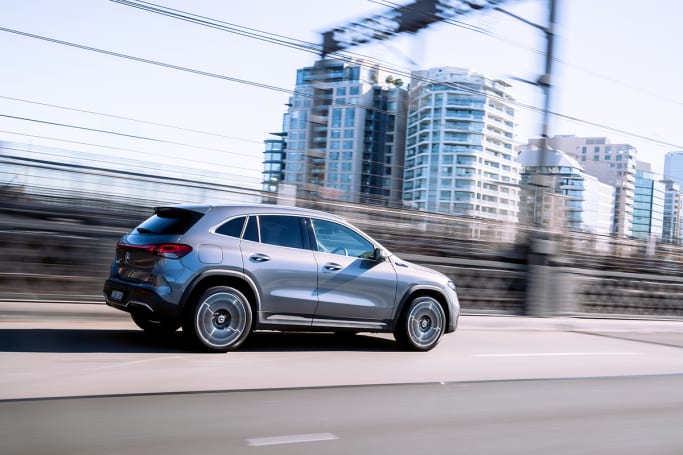
When you do need to use the friction brakes, like other all-electric vehicles, the transition to them isn’t the smoothest. In fact, they’re quite grabby initially.
Most drivers can probably fine-tune their inputs over time to counteract this, but it’s still a thing, nonetheless.
Handling-wise, the EQA 250 doesn’t exhibit that much body roll, considering it’s an SUV, although the underfloor positioning of its battery helps to lower its centre of gravity.
Speaking of which, the EQA 250’s two-tonne-plus kerb weight is undeniable when pushing hard through the bends, often causing understeer and therefore working against the driver.
Another factor to consider is grip, the EQA 250’s front tyres can be overwhelmed when encountering a heavy right foot off the line or out of a bend. The upcoming AWD EQA 350 is unlikely to suffer from the same problem.
What feels much sportier, though, is the EQA 250’s electric power steering, which is surprisingly direct when attacking the twist stuffy. It’s also appreciably light in hand, unless the Sport drive mode is called upon, in which case a decent amount of heft is added.
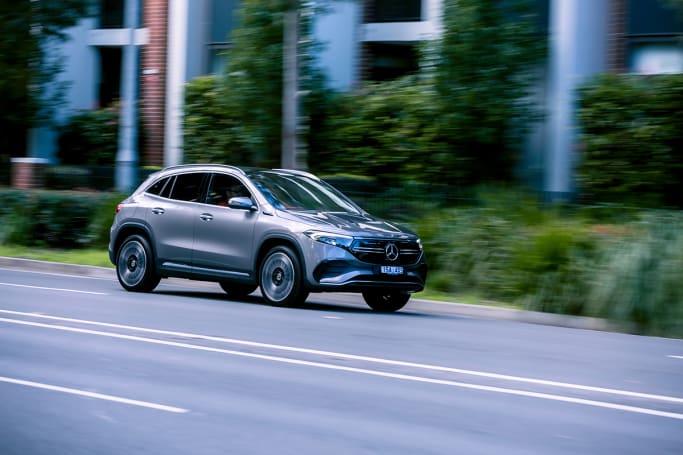
Despite stiffer springs dealing with battery’s extra weight, the EQA 250’s ride is also pretty comfortable, although our test vehicle had the AMG Line package fitted, with its 20-inch alloy wheels managing to catch road imperfections a little too easily.
Of course, the suspension set-up (independent MacPherson-strut front and multi-link rear axles) does come with adaptive dampers, but they’re best left in their Comfort setting, as the Sport mode reduces the ride quality while not meaningfully improving handling.
And as far as noise levels are concerned, without an engine labouring away, wind and tyre noise have become quite prominent in the EQA 250, although turning up the sound system does help to drown them out. Either way, more sound deadening would have been nice.
The EQA is clearly a big step forward for Mercedes-Benz and the premium segment in general, with the EQA 250 offering compelling real-world range in an attractive package, although it is relatively expensive.
And for those buyers that like a little extra oomph, it will be worth waiting for the EQA 350, which will deliver much more spritely straight-line performance. Either way, the EQA should be taken seriously.
| Vehicle | Specs | Price* | |
|---|---|---|---|
| EQA 250 | —, Electric, 1 SP AUTO | $74,140 – 85,250 | 2022 Mercedes-Benz EQ-Class 2022 EQA 250 Pricing and Specs |
| EQA 250 Edition 1 | —, Electric, 1 SP AUTO | $76,340 – 87,780 | 2022 Mercedes-Benz EQ-Class 2022 EQA 250 Edition 1 Pricing and Specs |
| EQC 400 4Matic | —, Electric, 1 SP AUTO | $115,390 – 132,660 | 2022 Mercedes-Benz EQ-Class 2022 EQC 400 4Matic Pricing and Specs |
| EQC 400 4Matic Electric ART Line | —, Electric, 1 SP AUTO | $136,180 – 156,530 | 2022 Mercedes-Benz EQ-Class 2022 EQC 400 4Matic Electric ART Line Pricing and Specs |
| Price and features | 7 |
|---|---|
| Design | 8 |
| Practicality | 7 |
| Under the bonnet | 7 |
| Efficiency | 8 |
| Safety | 8 |
| Ownership | 9 |
| Driving | 7 |
$59,888
Lowest price, based on 5 car listings in the last 6 months